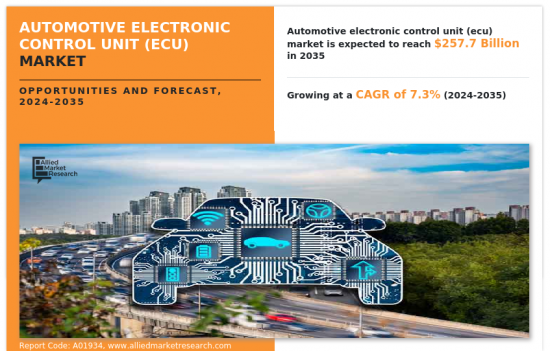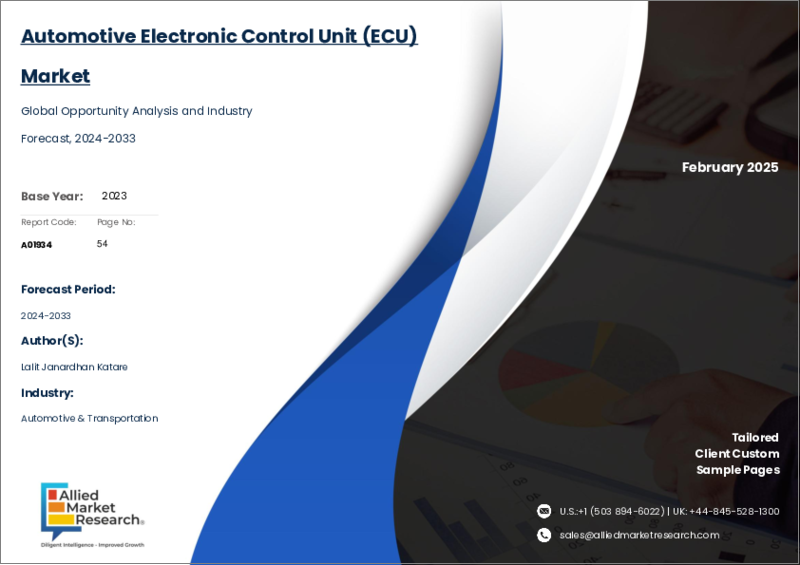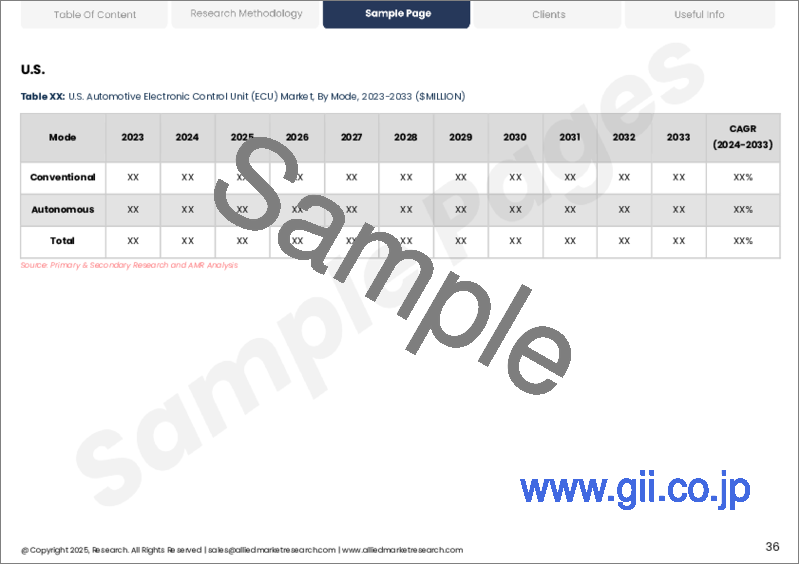|
|
市場調査レポート
商品コード
1641733
自動車用電子制御ユニットの世界市場:技術別、用途別、モード別、ECU容量別、タイプ別 - 機会分析と産業予測(2024年~2035年)Automotive Electronic Control Unit Market By Technology, By Application, By Mode, By ECU Capacity, By Type : Global Opportunity Analysis and Industry Forecast, 2024-2035 |
||||||
|
|||||||
| 自動車用電子制御ユニットの世界市場:技術別、用途別、モード別、ECU容量別、タイプ別 - 機会分析と産業予測(2024年~2035年) |
|
出版日: 2024年11月01日
発行: Allied Market Research
ページ情報: 英文 366 Pages
納期: 2~3営業日
|
- 全表示
- 概要
- 目次
自動車用電子制御ユニット(ECU)は、エンジン性能、安全機能、インフォテインメントなど、さまざまな電子システムや機能を管理・制御するために自動車に組み込まれた専用コンピュータです。

自動車におけるモノのインターネット(IoT)とスマート技術の統合が、自動車用電子制御ユニット(ECU)市場の需要を大きく牽引しています。車両がますます接続され、リアルタイムのデータ監視、遠隔診断、高度なインフォテインメントシステムなどのIoT対応機能を搭載するようになると、電子制御要件の複雑さと量が増加します。スマートテクノロジーには、さまざまなセンサーや通信モジュールからのデータを管理・処理し、シームレスな接続性と機能性を確保するための高度なECUが必要です。このような統合により、車両の性能、安全性、ユーザー体験が向上するため、これらの技術革新をサポートできる高度なECUの必要性が高まっています。
さらに、V2X(Vehicle-to-Everything)通信や自律走行技術が重視されるようになったことで、複雑なデータ処理やシステム調整に対応できる高性能ECUへの需要がさらに高まっています。その結果、自動車におけるIoTとスマート技術の普及が、自動車用ECU市場の拡大と進化を促す重要な要因となっています。したがって、自動車におけるIoTとスマート技術の統合が、自動車用ECU市場の需要を牽引しています。
自動車用電子制御ユニットの需要増加に伴う継続的な需要増に対応するため、さまざまな企業が現在のサービスを拡大しています。例えば、2023年2月、コンチネンタルの発表は、この地域の主要自動車メーカーがADAS(先進運転支援システム)技術を導入したことで、インドの自動車産業にとって極めて重要な瞬間を浮き彫りにしました。この進歩は、自動車の安全性と自動化における大きな飛躍を意味し、運転体験の向上と事故削減への取り組みの高まりを反映しています。ADASには、アダプティブクルーズコントロール、レーンキーピングアシスタンス、自動緊急ブレーキなどの革新的な機能が含まれ、これらはすべて、現代の複雑な道路を走行するドライバーを支援するために設計されています。インドの自動車メーカーは、これらの技術を統合することで、自動車の安全性を向上させるだけでなく、世界の自動車動向に合わせ、インドの自動車市場における技術革新と安全基準の新たな基準を設定しています。
さらに、自動車用電子制御ユニットプロバイダー間の提携が増加していることも、同市場の追い風となっています。例えば、コンチネンタルは2024年4月、欧州とアジアの自動車メーカー向けにゾーンコントロールユニット(ZCU)を導入し、高性能コンピュータを超えるサーバーベースシステムを強化することで、サーバーベースの車両アーキテクチャを推進しています。複数の世界の顧客から受注しているこれらのZCUは、ソフトウェアで定義された自動車の階層型アーキテクチャにおける重要なコンポーネントであり、コンチネンタルのエレクトロニクスのスペシャリストは、先進的なソフトウェア主導の自動車ソリューション開発の最前線に位置しています。
例えば、2024年4月、マレリは、インフィニオンと共同で開発した最新のゾーンコントロールユニットをAuto Chinaショーで紹介し、照明、車体、推進力などさまざまな車両領域にわたる複数のECUを統合し、スケーラブルなソリューションとした先進の電子制御ユニットを披露しました。このイノベーションは、クロスドメインの専門知識、サービス指向のソフトウェア、クラウド仮想化を通じてソフトウェア定義の車両を変革し、車両のカスタマイズとパーソナライゼーションを強化する道を開くという、マレリのリーダーシップを示すものでした。
パーソナライズされたコネクテッドな車両体験に対する需要の高まりは、自動車用電子制御ユニット(ECU)市場に有利な機会をもたらします。消費者が自分の好みに合わせた車両を求める傾向が強まる中、ECUは高度なカスタマイズ機能を実現する上で極めて重要な役割を果たしています。これらのユニットは、リアルタイムのデータ処理とさまざまな車載システム間の通信を促進し、シートポジション、空調制御、インフォテインメント設定などの個人設定をシームレスに統合できるようにします。
例えば、2021年4月、株式会社デンソーは、車両の位置を正確に特定するための空間情報サービス電子制御ユニット(SIS ECU)と、これらの製品から配信される情報を高速処理するための先進ドライブシステム電子制御ユニット(ADS ECU)および先進ドライブ拡張電子制御ユニット(ADX ECU)を備えた先進運転支援技術を開発しました。このように、新技術の採用により、自動車の電子制御およびソフトウェアコンテンツが増加し、その結果、予測期間中に電子制御ユニット(ECU)の需要が増加しています。
さらに、モノのインターネット(IoT)技術の進歩によるコネクテッドカーの台頭により、車両と外部ネットワーク間の複雑なデータフローを管理できる高度なECUのニーズが高まっています。このコネクティビティによって、遠隔診断、無線ソフトウェアアップデート、V2X(Vehicle-to-Everything)通信などの機能が実現し、運転体験と安全性の両方が向上します。自動車メーカー各社は、このような先進機能に対する消費者の需要の高まりに応えようと努力しており、ECU市場は大きな成長を遂げようとしています。
また、最先端ECU技術の開発に投資する企業は、この動向を利用するのに有利な立場にあり、現代のドライバーの進化する期待に応えるソリューションを提供することができます。この市場機会は、最適な性能と機能性を実現するために高度なECUに大きく依存する電気自動車や自律走行車の採用増加によってさらに増幅されます。したがって、パーソナライズされたコネクテッドな車両体験に対する需要の高まりは、自動車用電子制御ユニット市場にとって有利な機会です。
自動車用電子制御ユニット市場は、技術、用途、モード、ECU容量、タイプ、地域によって区分されます。技術ベースでは、市場はパワートレイン、ボディ、ADAS、インフォテインメント、シャーシに分類されます。用途ベースでは、市場は乗用車、商用車、電気自動車に二分されます。モード別では、市場は従来型と自律型に分類されます。ECU容量ベースでは、市場は16ビット、32ビット、64ビットに分類されます。タイプ別では、スマートアクチュエータまたはエッジノード、セントラルECUまたはドメインECU、ゾーンECU、その他に分類されます。地域別では、市場は北米、欧州、アジア太平洋、ラテンアメリカ、中東・アフリカで分析されます。
本レポートはカスタマイズが可能です。
- 技術動向分析
- 企業の市場シェア分析:製品/セグメント別
- 戦略的提言
- 顧客の関心に応じた追加企業プロファイル
- 主要企業の詳細(所在地、連絡先、サプライヤー/ベンダーネットワークなどを含む、エクセル形式)
- SWOT分析
目次
第1章 イントロダクション
第2章 エグゼクティブサマリー
第3章 市場概要
- 市場の定義と範囲
- 主な調査結果
- 影響要因
- 主な投資機会
- ポーターのファイブフォース分析
- 市場力学
- 促進要因
- ADAS(先進運転支援システム)の需要増加
- 自動車におけるIoTとスマート技術の統合
- カーエレクトロニクスとコネクティビティの進歩
- 抑制要因
- 既存の車両システムとの統合の複雑さ
- 先進電子制御ユニットの高コスト
- 機会
- 次世代カーエレクトロニクスとセンサーの開発
- パーソナライズされたコネクテッドカー体験に対する需要の高まり
- 促進要因
第4章 自動車用電子制御ユニット(ECU)市場:技術別
- 概要
- パワートレイン
- ボディ
- ADAS
- インフォテインメント
- シャーシ
第5章 自動車用電子制御ユニット(ECU)市場:用途別
- 概要
- 乗用車
- 商用車
- 電気自動車
第6章 自動車用電子制御ユニット(ECU)市場:モード別
- 概要
- 従来型
- 自律型
第7章 自動車用電子制御ユニット(ECU)市場:ECU容量別
- 概要
- 16ビット
- 32ビット
- 64ビット
第8章 自動車用電子制御ユニット(ECU)市場:タイプ別
- 概要
- スマートアクチュエータまたはエッジノード
- セントラルECUまたはドメインECU
- ゾーンECU
- その他
第9章 自動車用電子制御ユニット(ECU)市場:地域別
- 概要
- 北米
- 米国
- カナダ
- メキシコ
- 欧州
- フランス
- ドイツ
- イタリア
- 英国
- その他
- アジア太平洋
- 中国
- 日本
- インド
- 韓国
- その他
- ラテンアメリカ
- ラテンアメリカ
- 中東
- アフリカ
第10章 競合情勢
- イントロダクション
- 主要成功戦略
- 主要10社の製品マッピング
- 競合ダッシュボード
- 競合ヒートマップ
- 主要企業のポジショニング(2023年)
第11章 企業プロファイル
- Aptiv
- Continental AG
- DENSO CORPORATION
- Hitachi Astemo, Ltd.
- HYUNDAI MOBIS
- Lear Corp.
- Marelli Holdings Co., Ltd
- Panasonic Holdings Corporation
- Robert Bosch GmbH
- Pektron Group Ltd
An automotive ECU (Electronic Control Unit) is a specialized computer embedded in vehicles to manage and control various electronic systems and functions, such as engine performance, safety features, and infotainment.

The integration of Internet of Things (IoT) and smart technologies in vehicles is significantly driving the demand for the automotive electronic control unit (ECU) market. As vehicles become increasingly connected and equipped with IoT-enabled features, such as real-time data monitoring, remote diagnostics, and advanced infotainment systems, the complexity and volume of electronic control requirements rise. Smart technologies necessitate sophisticated ECUs to manage and process data from various sensors and communication modules, ensuring seamless connectivity and functionality. This integration enhances vehicle performance, safety, and user experience, driving the need for advanced ECUs capable of supporting these innovations.
Furthermore, the growing emphasis on vehicle-to-everything (V2X) communication and autonomous driving technologies further fuels the demand for high-performance ECUs that can handle intricate data processing and system coordination. Consequently, the proliferation of IoT and smart technologies in vehicles is a key factor propelling the expansion and evolution of the automotive ECU market. Therefore, integration of IoT and smart technologies in vehicles is driving the demand for the automotive electronic control unit market.
Various companies are expanding their current services to meet the continuous rise in demand with increase in demand for automotive electronic control unit. For instance, in February 2023, Continental's announcement highlights a pivotal moment for India's automotive industry, as leading automakers in the region have introduced advanced driver assistance systems (ADAS) technology. This advancement represents a significant leap forward in vehicle safety and automation, reflecting a growing commitment to enhancing driving experiences and reducing accidents. ADAS encompasses a range of innovative features such as adaptive cruise control, lane-keeping assistance, and automatic emergency braking, all designed to assist drivers in navigating the complexities of modern roads. By integrating these technologies, Indian automakers are not only improving vehicle safety but also aligning with global automotive trends, setting a new benchmark for innovation and safety standards in the Indian automotive market.
Furthermore, the market is also benefiting from an increase in partnerships between automotive electronic control unit providers. For instance, in April 2024, Continental is advancing server-based vehicle architectures by introducing Zone Control Units (ZCUs) for European and Asian car manufacturers, enhancing their server-based systems beyond high-performance computers. With multiple global customer orders, these ZCUs represent a critical component in the tiered architecture of software-defined vehicles, positioning Continental's electronics specialists at the forefront of developing advanced, software-driven automotive solutions.
For instance, in April 2024, Marelli highlighted its latest Zone Control Unit, developed in partnership with Infineon, at the Auto China show, showcasing its advanced electronic control units that integrated multiple ECUs across various vehicle domains such as lighting, body, and propulsion into a cohesive, scalable solution. This innovation exemplified Marelli's leadership in transforming software-defined vehicles through cross-domain expertise, service-oriented software, and cloud virtualization, paving the way for enhanced vehicle customization and personalization.
The rise in demand for personalized and connected vehicle experiences presents a lucrative opportunity for the automotive electronic control unit (ECU) market. As consumers increasingly seek vehicles tailored to their preferences, ECUs play a pivotal role in enabling advanced customization features. These units facilitate real-time data processing and communication between various in-vehicle systems, allowing for seamless integration of personalized settings such as seat positions, climate control, and infotainment preferences.
For instance, in April 2021, DENSO Corporation developed its advanced driver assistance technology with Spatial Information Service Electronic Control Unit (SIS ECU) for accurately identifying the position of the vehicle and an Advanced Drive System Electronic Control Unit (ADS ECU) & Advanced Drive Extension Electronic Control Unit (ADX ECU) for high-speed processing of information delivered by these products. Thus, the adoption of new technologies has witnessed an increase in electronic and software content in vehicles, consequently increasing the demand for electronic control units (ECU) during the forecast period.
Moreover, the rise of connected vehicles, driven by advancements in Internet of Things (IoT) technology, has heightened the need for sophisticated ECUs that can manage complex data flows between the vehicle and external networks. This connectivity enables features such as remote diagnostics, over-the-air software updates, and vehicle-to-everything (V2X) communication, enhancing both the driving experience and safety. As automakers strive to meet the growing consumer demand for such advanced features, the ECU market is poised for significant growth.
In addition, companies that invest in developing cutting-edge ECU technologies will be well-positioned to capitalize on this trend, offering solutions that cater to the evolving expectations of modern drivers. This market opportunity is further amplified by the increasing adoption of electric and autonomous vehicles, which rely heavily on advanced ECUs for optimal performance and functionality. Therefore, rise in demand for personalized and connected vehicle experiences is lucrative opportunity for the automotive electronic control unit market.
The automotive electronic control unit market is segmented on the basis of technology, application, mode, ECU capacity, type, and region. On the basis of technology, the market is classified into powertrain, body, ADAS, infotainment, and chassis. On the basis of application, the market is bifurcated into passenger cars, commercial vehicle, and electric vehicles. On the basis of mode, the market is categorized into conventional, and autonomous. On the basis of ECU Capacity, the market is divided into 16 Bit, 32 Bit, and 64 Bit. On the basis of type, the market is divided into Smart Actuator or Edge Node, Central ECU or Domain ECU, Zonal ECU, and Others. On the basis of region, the market is analyzed across North America, Europe, Asia-Pacific, Latin America. and Middles East & Africa.
The key players in the automotive electronic control unit market are Aptiv, Continental Ag, Denso Corporation, Hitachi Astemo, Ltd, Hyundai Mobis Co Ltd, Lear Corporation, Marelli Holdings Co., Ltd, Panasonic Corporation, Robert Bosch Gmbh, and Pektron.
Additional benefits you will get with this purchase are:
- Quarterly Update and* (only available with a corporate license, on listed price)
- 5 additional Company Profile of client Choice pre- or Post-purchase, as a free update.
- Free Upcoming Version on the Purchase of Five and Enterprise User License.
- 16 analyst hours of support* (post-purchase, if you find additional data requirements upon review of the report, you may receive support amounting to 16 analyst hours to solve questions, and post-sale queries)
- 15% Free Customization* (in case the scope or segment of the report does not match your requirements, 15% is equivalent to 3 working days of free work, applicable once)
- Free data Pack on the Five and Enterprise User License. (Excel version of the report)
- Free Updated report if the report is 6-12 months old or older.
- 24-hour priority response*
- Free Industry updates and white papers.
Possible Customization with this report (with additional cost and timeline, please talk to the sales executive to know more)
- Technology Trend Analysis
- Market share analysis of players by products/segments
- Strategic Recommedations
- Additional company profiles with specific to client's interest
- Key player details (including location, contact details, supplier/vendor network etc. in excel format)
- SWOT Analysis
Key Market Segments
By Technology
- Powertrain
- Body
- ADAS
- Infotainment
- Chassis
By Application
- Electric Vehicles
- Passenger Cars
- Commercial Vehicle
By Mode
- Conventional
- Autonomous
By ECU Capacity
- 16 Bit
- 32 Bit
- 64 Bit
By Type
- Smart Actuator or Edge Node
- Central ECU or Domain ECU
- Zonal ECU
- Others
By Region
- North America
- U.S.
- Canada
- Mexico
- Europe
- France
- Germany
- Italy
- UK
- Rest of Europe
- Asia-Pacific
- China
- Japan
- India
- South Korea
- Rest of Asia-Pacific
- LAMEA
- Latin America
- Middle East
- Africa
Key Market Players:
- Aptiv
- Continental AG
- DENSO CORPORATION
- Hitachi Astemo, Ltd.
- HYUNDAI MOBIS
- Lear Corp.
- Marelli Holdings Co., Ltd
- Panasonic Holdings Corporation
- Pektron Group Ltd
- Robert Bosch GmbH
TABLE OF CONTENTS
CHAPTER 1: INTRODUCTION
- 1.1. Report description
- 1.2. Key market segments
- 1.3. Key benefits to the stakeholders
- 1.4. Research methodology
- 1.4.1. Primary research
- 1.4.2. Secondary research
- 1.4.3. Analyst tools and models
CHAPTER 2: EXECUTIVE SUMMARY
- 2.1. CXO perspective
CHAPTER 3: MARKET OVERVIEW
- 3.1. Market definition and scope
- 3.2. Key findings
- 3.2.1. Top impacting factors
- 3.2.2. Top investment pockets
- 3.3. Porter's five forces analysis
- 3.3.1. Moderate bargaining power of suppliers
- 3.3.2. High threat of new entrants
- 3.3.3. Moderate threat of substitutes
- 3.3.4. High intensity of rivalry
- 3.3.5. High bargaining power of buyers
- 3.4. Market dynamics
- 3.4.1. Drivers
- 3.4.1.1. Rise in Demand for Advanced Driver Assistance Systems
- 3.4.1.2. Integration of IoT and Smart Technologies in Vehicles
- 3.4.1.3. Advancements in Automotive Electronics and Connectivity
- 3.4.2. Restraints
- 3.4.2.1. Complexity of Integration with Existing Vehicle Systems
- 3.4.2.2. High Cost of Advanced Electronic Control Units
- 3.4.3. Opportunities
- 3.4.3.1. Development of Next-Generation Automotive Electronics and Sensors
- 3.4.3.2. Rise in Demand for Personalized and Connected Vehicle Experiences
- 3.4.1. Drivers
CHAPTER 4: AUTOMOTIVE ELECTRONIC CONTROL UNIT (ECU) MARKET, BY TECHNOLOGY
- 4.1. Overview
- 4.1.1. Market size and forecast
- 4.2. Powertrain
- 4.2.1. Key market trends, growth factors and opportunities
- 4.2.2. Market size and forecast, by region
- 4.2.3. Market share analysis by country
- 4.3. Body
- 4.3.1. Key market trends, growth factors and opportunities
- 4.3.2. Market size and forecast, by region
- 4.3.3. Market share analysis by country
- 4.4. ADAS
- 4.4.1. Key market trends, growth factors and opportunities
- 4.4.2. Market size and forecast, by region
- 4.4.3. Market share analysis by country
- 4.5. Infotainment
- 4.5.1. Key market trends, growth factors and opportunities
- 4.5.2. Market size and forecast, by region
- 4.5.3. Market share analysis by country
- 4.6. Chassis
- 4.6.1. Key market trends, growth factors and opportunities
- 4.6.2. Market size and forecast, by region
- 4.6.3. Market share analysis by country
CHAPTER 5: AUTOMOTIVE ELECTRONIC CONTROL UNIT (ECU) MARKET, BY APPLICATION
- 5.1. Overview
- 5.1.1. Market size and forecast
- 5.2. Passenger Cars
- 5.2.1. Key market trends, growth factors and opportunities
- 5.2.2. Market size and forecast, by region
- 5.2.3. Market share analysis by country
- 5.3. Commercial Vehicle
- 5.3.1. Key market trends, growth factors and opportunities
- 5.3.2. Market size and forecast, by region
- 5.3.3. Market share analysis by country
- 5.4. Electric Vehicles
- 5.4.1. Key market trends, growth factors and opportunities
- 5.4.2. Market size and forecast, by region
- 5.4.3. Market share analysis by country
CHAPTER 6: AUTOMOTIVE ELECTRONIC CONTROL UNIT (ECU) MARKET, BY MODE
- 6.1. Overview
- 6.1.1. Market size and forecast
- 6.2. Conventional
- 6.2.1. Key market trends, growth factors and opportunities
- 6.2.2. Market size and forecast, by region
- 6.2.3. Market share analysis by country
- 6.3. Autonomous
- 6.3.1. Key market trends, growth factors and opportunities
- 6.3.2. Market size and forecast, by region
- 6.3.3. Market share analysis by country
CHAPTER 7: AUTOMOTIVE ELECTRONIC CONTROL UNIT (ECU) MARKET, BY ECU CAPACITY
- 7.1. Overview
- 7.1.1. Market size and forecast
- 7.2. 16 Bit
- 7.2.1. Key market trends, growth factors and opportunities
- 7.2.2. Market size and forecast, by region
- 7.2.3. Market share analysis by country
- 7.3. 32 Bit
- 7.3.1. Key market trends, growth factors and opportunities
- 7.3.2. Market size and forecast, by region
- 7.3.3. Market share analysis by country
- 7.4. 64 Bit
- 7.4.1. Key market trends, growth factors and opportunities
- 7.4.2. Market size and forecast, by region
- 7.4.3. Market share analysis by country
CHAPTER 8: AUTOMOTIVE ELECTRONIC CONTROL UNIT (ECU) MARKET, BY TYPE
- 8.1. Overview
- 8.1.1. Market size and forecast
- 8.2. Smart Actuator or Edge Node
- 8.2.1. Key market trends, growth factors and opportunities
- 8.2.2. Market size and forecast, by region
- 8.2.3. Market share analysis by country
- 8.3. Central ECU or Domain ECU
- 8.3.1. Key market trends, growth factors and opportunities
- 8.3.2. Market size and forecast, by region
- 8.3.3. Market share analysis by country
- 8.4. Zonal ECU
- 8.4.1. Key market trends, growth factors and opportunities
- 8.4.2. Market size and forecast, by region
- 8.4.3. Market share analysis by country
- 8.5. Others
- 8.5.1. Key market trends, growth factors and opportunities
- 8.5.2. Market size and forecast, by region
- 8.5.3. Market share analysis by country
CHAPTER 9: AUTOMOTIVE ELECTRONIC CONTROL UNIT (ECU) MARKET, BY REGION
- 9.1. Overview
- 9.1.1. Market size and forecast By Region
- 9.2. North America
- 9.2.1. Key market trends, growth factors and opportunities
- 9.2.2. Market size and forecast, by Technology
- 9.2.3. Market size and forecast, by Application
- 9.2.4. Market size and forecast, by Mode
- 9.2.5. Market size and forecast, by ECU Capacity
- 9.2.6. Market size and forecast, by Type
- 9.2.7. Market size and forecast, by country
- 9.2.7.1. U.S.
- 9.2.7.1.1. Market size and forecast, by Technology
- 9.2.7.1.2. Market size and forecast, by Application
- 9.2.7.1.3. Market size and forecast, by Mode
- 9.2.7.1.4. Market size and forecast, by ECU Capacity
- 9.2.7.1.5. Market size and forecast, by Type
- 9.2.7.2. Canada
- 9.2.7.2.1. Market size and forecast, by Technology
- 9.2.7.2.2. Market size and forecast, by Application
- 9.2.7.2.3. Market size and forecast, by Mode
- 9.2.7.2.4. Market size and forecast, by ECU Capacity
- 9.2.7.2.5. Market size and forecast, by Type
- 9.2.7.3. Mexico
- 9.2.7.3.1. Market size and forecast, by Technology
- 9.2.7.3.2. Market size and forecast, by Application
- 9.2.7.3.3. Market size and forecast, by Mode
- 9.2.7.3.4. Market size and forecast, by ECU Capacity
- 9.2.7.3.5. Market size and forecast, by Type
- 9.3. Europe
- 9.3.1. Key market trends, growth factors and opportunities
- 9.3.2. Market size and forecast, by Technology
- 9.3.3. Market size and forecast, by Application
- 9.3.4. Market size and forecast, by Mode
- 9.3.5. Market size and forecast, by ECU Capacity
- 9.3.6. Market size and forecast, by Type
- 9.3.7. Market size and forecast, by country
- 9.3.7.1. France
- 9.3.7.1.1. Market size and forecast, by Technology
- 9.3.7.1.2. Market size and forecast, by Application
- 9.3.7.1.3. Market size and forecast, by Mode
- 9.3.7.1.4. Market size and forecast, by ECU Capacity
- 9.3.7.1.5. Market size and forecast, by Type
- 9.3.7.2. Germany
- 9.3.7.2.1. Market size and forecast, by Technology
- 9.3.7.2.2. Market size and forecast, by Application
- 9.3.7.2.3. Market size and forecast, by Mode
- 9.3.7.2.4. Market size and forecast, by ECU Capacity
- 9.3.7.2.5. Market size and forecast, by Type
- 9.3.7.3. Italy
- 9.3.7.3.1. Market size and forecast, by Technology
- 9.3.7.3.2. Market size and forecast, by Application
- 9.3.7.3.3. Market size and forecast, by Mode
- 9.3.7.3.4. Market size and forecast, by ECU Capacity
- 9.3.7.3.5. Market size and forecast, by Type
- 9.3.7.4. UK
- 9.3.7.4.1. Market size and forecast, by Technology
- 9.3.7.4.2. Market size and forecast, by Application
- 9.3.7.4.3. Market size and forecast, by Mode
- 9.3.7.4.4. Market size and forecast, by ECU Capacity
- 9.3.7.4.5. Market size and forecast, by Type
- 9.3.7.5. Rest of Europe
- 9.3.7.5.1. Market size and forecast, by Technology
- 9.3.7.5.2. Market size and forecast, by Application
- 9.3.7.5.3. Market size and forecast, by Mode
- 9.3.7.5.4. Market size and forecast, by ECU Capacity
- 9.3.7.5.5. Market size and forecast, by Type
- 9.4. Asia-Pacific
- 9.4.1. Key market trends, growth factors and opportunities
- 9.4.2. Market size and forecast, by Technology
- 9.4.3. Market size and forecast, by Application
- 9.4.4. Market size and forecast, by Mode
- 9.4.5. Market size and forecast, by ECU Capacity
- 9.4.6. Market size and forecast, by Type
- 9.4.7. Market size and forecast, by country
- 9.4.7.1. China
- 9.4.7.1.1. Market size and forecast, by Technology
- 9.4.7.1.2. Market size and forecast, by Application
- 9.4.7.1.3. Market size and forecast, by Mode
- 9.4.7.1.4. Market size and forecast, by ECU Capacity
- 9.4.7.1.5. Market size and forecast, by Type
- 9.4.7.2. Japan
- 9.4.7.2.1. Market size and forecast, by Technology
- 9.4.7.2.2. Market size and forecast, by Application
- 9.4.7.2.3. Market size and forecast, by Mode
- 9.4.7.2.4. Market size and forecast, by ECU Capacity
- 9.4.7.2.5. Market size and forecast, by Type
- 9.4.7.3. India
- 9.4.7.3.1. Market size and forecast, by Technology
- 9.4.7.3.2. Market size and forecast, by Application
- 9.4.7.3.3. Market size and forecast, by Mode
- 9.4.7.3.4. Market size and forecast, by ECU Capacity
- 9.4.7.3.5. Market size and forecast, by Type
- 9.4.7.4. South Korea
- 9.4.7.4.1. Market size and forecast, by Technology
- 9.4.7.4.2. Market size and forecast, by Application
- 9.4.7.4.3. Market size and forecast, by Mode
- 9.4.7.4.4. Market size and forecast, by ECU Capacity
- 9.4.7.4.5. Market size and forecast, by Type
- 9.4.7.5. Rest of Asia-Pacific
- 9.4.7.5.1. Market size and forecast, by Technology
- 9.4.7.5.2. Market size and forecast, by Application
- 9.4.7.5.3. Market size and forecast, by Mode
- 9.4.7.5.4. Market size and forecast, by ECU Capacity
- 9.4.7.5.5. Market size and forecast, by Type
- 9.5. LAMEA
- 9.5.1. Key market trends, growth factors and opportunities
- 9.5.2. Market size and forecast, by Technology
- 9.5.3. Market size and forecast, by Application
- 9.5.4. Market size and forecast, by Mode
- 9.5.5. Market size and forecast, by ECU Capacity
- 9.5.6. Market size and forecast, by Type
- 9.5.7. Market size and forecast, by country
- 9.5.7.1. Latin America
- 9.5.7.1.1. Market size and forecast, by Technology
- 9.5.7.1.2. Market size and forecast, by Application
- 9.5.7.1.3. Market size and forecast, by Mode
- 9.5.7.1.4. Market size and forecast, by ECU Capacity
- 9.5.7.1.5. Market size and forecast, by Type
- 9.5.7.2. Middle East
- 9.5.7.2.1. Market size and forecast, by Technology
- 9.5.7.2.2. Market size and forecast, by Application
- 9.5.7.2.3. Market size and forecast, by Mode
- 9.5.7.2.4. Market size and forecast, by ECU Capacity
- 9.5.7.2.5. Market size and forecast, by Type
- 9.5.7.3. Africa
- 9.5.7.3.1. Market size and forecast, by Technology
- 9.5.7.3.2. Market size and forecast, by Application
- 9.5.7.3.3. Market size and forecast, by Mode
- 9.5.7.3.4. Market size and forecast, by ECU Capacity
- 9.5.7.3.5. Market size and forecast, by Type
CHAPTER 10: COMPETITIVE LANDSCAPE
- 10.1. Introduction
- 10.2. Top winning strategies
- 10.3. Product mapping of top 10 player
- 10.4. Competitive dashboard
- 10.5. Competitive heatmap
- 10.6. Top player positioning, 2023
CHAPTER 11: COMPANY PROFILES
- 11.1. Aptiv
- 11.1.1. Company overview
- 11.1.2. Key executives
- 11.1.3. Company snapshot
- 11.1.4. Operating business segments
- 11.1.5. Product portfolio
- 11.1.6. Business performance
- 11.1.7. Key strategic moves and developments
- 11.2. Continental AG
- 11.2.1. Company overview
- 11.2.2. Key executives
- 11.2.3. Company snapshot
- 11.2.4. Operating business segments
- 11.2.5. Product portfolio
- 11.2.6. Business performance
- 11.2.7. Key strategic moves and developments
- 11.3. DENSO CORPORATION
- 11.3.1. Company overview
- 11.3.2. Key executives
- 11.3.3. Company snapshot
- 11.3.4. Operating business segments
- 11.3.5. Product portfolio
- 11.3.6. Business performance
- 11.3.7. Key strategic moves and developments
- 11.4. Hitachi Astemo, Ltd.
- 11.4.1. Company overview
- 11.4.2. Key executives
- 11.4.3. Company snapshot
- 11.4.4. Operating business segments
- 11.4.5. Product portfolio
- 11.4.6. Business performance
- 11.4.7. Key strategic moves and developments
- 11.5. HYUNDAI MOBIS
- 11.5.1. Company overview
- 11.5.2. Key executives
- 11.5.3. Company snapshot
- 11.5.4. Operating business segments
- 11.5.5. Product portfolio
- 11.5.6. Business performance
- 11.6. Lear Corp.
- 11.6.1. Company overview
- 11.6.2. Key executives
- 11.6.3. Company snapshot
- 11.6.4. Operating business segments
- 11.6.5. Product portfolio
- 11.6.6. Business performance
- 11.7. Marelli Holdings Co., Ltd
- 11.7.1. Company overview
- 11.7.2. Key executives
- 11.7.3. Company snapshot
- 11.7.4. Operating business segments
- 11.7.5. Product portfolio
- 11.7.6. Key strategic moves and developments
- 11.8. Panasonic Holdings Corporation
- 11.8.1. Company overview
- 11.8.2. Key executives
- 11.8.3. Company snapshot
- 11.8.4. Operating business segments
- 11.8.5. Product portfolio
- 11.8.6. Business performance
- 11.9. Robert Bosch GmbH
- 11.9.1. Company overview
- 11.9.2. Key executives
- 11.9.3. Company snapshot
- 11.9.4. Operating business segments
- 11.9.5. Product portfolio
- 11.9.6. Business performance
- 11.10. Pektron Group Ltd
- 11.10.1. Company overview
- 11.10.2. Key executives
- 11.10.3. Company snapshot
- 11.10.4. Operating business segments
- 11.10.5. Product portfolio





